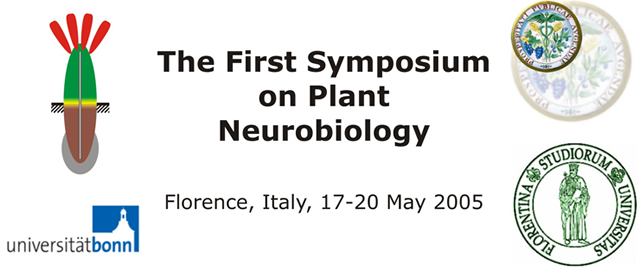
 |
| Oxygen/Auxin influx and NO efflux: neural-like features of the transtion zone of the root apex |
| Stefano Mancuso1,*, Sergio Mugnai1, Anna Maria Marras2, Dieter Volkmann3, František Baluška3 |
|
1 Dept. Horticulture, University of
Firenze, Viale delle idee 30, 50019 Sesto F.no (FI), Italy 2 Dept. of Pharmaceutical Science, University of Firenze, via Ugo Schiff 6, 50019 Sesto Fiorentino (FI), Italy 3 IZMB, University of Bonn, Kirschallee 1, D-53115 Bonn, Germany |
| *email: stefano.mancuso@unifi.it |
|
Root apices are
composed of three distinct regions: an apical meristem where all cell divisions are taking place, a basal
region of rapid cell elongation where cells extend parallel to the apical-basal axis of the root, and an
interpolated transition zone (TZ). In contrast, shoot apices do not show such a clear zonation since cell
divisions and rapid cell elongation occur side-by-side. In the root apex, the transition zone cells maintain
an active cytoarchitecture, having central nuclei from which radiate both microtubules and actin filaments
towards the peripheral plasma membrane. This specific cytoarchitecture is proposed to be optimally suited for
the effective signal transmission between the plasma membrane and nucleus (Baluška et al. 2003a). Cells
of the distal part of the transition zone, occupying approximately the region of 1,0 – 1,5 mm from the
root tip, but not those of the meristem (approx. 0,0 – 1,0 mm from the root tip) and elongation region
(approx. 2,0 – 7,0 mm from the tip), are characterized by the maximal degree of oxygen and IAA influx
(Mancuso et al. 2005) into the root apex. Moreover, cells of the TZ are also specifically involved in the
production of NO in response to environmental stimuli such as hypoxia. Immediately after the onset of hypoxia,
NO is emitted specifically from the TZ of the root apex with a mean peak efflux of 925 ± 102 fmol NO
cm-2s-1. Approximately 230 pmol NO cm-2 are produced at the TZ.
Interestingly, dramatic NO efflux was recorded only in the TZ of the root apex. Outside of the TZ, only small
effluxes of NO (1/10 lower than those produced in the TZ) were detectable.
|
| [Back] |
Last Update on 06-06-05 by Andrej |
|